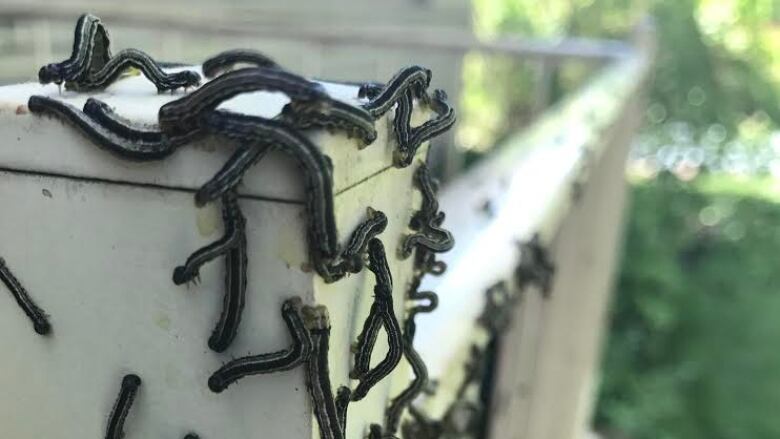Cankerworm infestation prompting Mississauga to consider aerial spraying
The city is ground spraying city-owned trees and using sticky bands to catch the inchworms

A cankerworm infestation inMississauga, Ont.,has acity councillor calling for the aerial spraying of affected trees.
The city is just one of many in Canada that has seen large bug infestations this year. Tent caterpillar infestations have blanketed some homesin Manitoba and Saskatchewan, while Newfoundland has seen at least one case of a large crane fly larvae infestation.
Cities and homeowners have so far struggled to find a way to keep the infestations under control, but on Wednesday, MississaugaCoun.Karen Raspassed a motion for city staff to come back with a report looking at the plausibility of aerial spraying in 2018to tackle the city's cankerworm problem.
"The trees in our area have been under stress for so many years," Ras said.
"And the biggest concern is if the city doesn't step up to do something and undertake an aerial spraying program next spring, then I'm really worried about the long term health of the trees."

Cankerworm caterpillars also known as loopers or inchworms areknown to emerge in the spring and fall and aremost commonly found on hardwood trees such as oak, maple, and elm.
They feast on the leaves of these trees, often stripping them bare, and leavethem more susceptible to disease and damage from other insects and extreme weather.
The warmer-than-normalwinter has resulted in an influx ofcankerworms, whichare taking over areas of Lorne Park and Whiteoaks Park in Mississauga.
- Wet spring may mean more mosquitoes but warmer than average summer on the way
- Forget butter, how about crickets on your popcorn?
Ras's office has been inundated with calls from residents who say they have been trapped inside their homes all spring because of the overwhelming amount of the pests.
Tracy Montgomeryand Charles Eddiehavelived in the area since 2000 and sayit gets worse each year.
"We've injected our trees to try to prevent this, we've vacuumed our house, we've scraped egg masses, we've sprayed [insecticide]as high up as we can reach to try to slow it down," said Montgomery.
"But it has to be aerial sprayed, and we've been after the city for several years to aerial spray... to no avail."

The city is currently ground spraying city-owned trees and using sticky bands to catch the caterpillars before they climb up the trees.
Residents, however, are having to shell out anywhere from $500 to $1000 to place band traps on privately owned trees, as well as injections, and BTK insecticidesolution and nearly double that to remove dead trees that never recover.
Longtime LornePark resident Ralph Hayfersays his biggest concern is the environmental impact of losing mature trees in the area.
"Over all these years there's been constant infestation, they've been under stress on a regular basis and whether or not they'regoing to come back is a real serious concern to us," he said.
"The impact of losing the foliage here will impact all of Mississauga."

Cankerworms naturally occur every 10 to 15 years and last for two to three years. They hatch in the spring and feed for five to six weeks before dropping from the trees on silk strands. They then spend the next six months of their lifecycle underground. The adult moths emerge in November or December and lay eggs in the tree canopy.
The most commonly used method for treating cankerwormand gypsy moth infestationsis BTK, a natural bacteria that kills moths and caterpillars upon ingestion. The city says it's been deemed safe because it isn't a chemical.
The last time the city aerial sprayed BTK was 10 years ago.












_(720p).jpg)


 OFFICIAL HD MUSIC VIDEO.jpg)
.jpg)



























































































